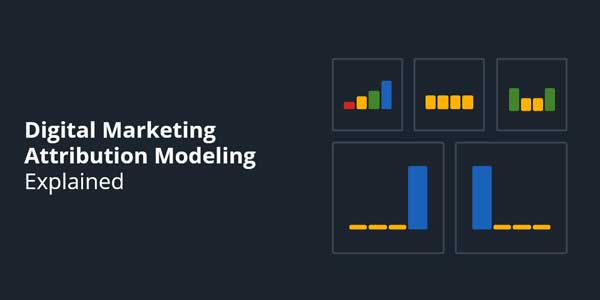
It’s not easy to figure out what makes people buy from you. However, you have to do it to improve your marketing efforts and get more of them to make the purchase. And what do you need to do it? Well, for starters, you need to know what attribution modelling is and why it matters.
In the perfect world, our visitors would click on one of our ads or posts, and they would convert into customers right away. It would be easy to prove the value of your marketing. As a matter of fact, it would be so easy that there would be no need to do it.
However, that’s not how things are in real life. It turns out that most people need more than 20 touch points before they make a purchase. Of course, the exact number will depend on the industry and the product you’re selling. But, the important thing is that they have to get in touch with your company multiple times before you can sell them anything.
Learn about attribution modelling, and you’ll get closer to the best internet marketing practices for your business. It’ll be easier for you to figure out what you need to do to drive your sales, so let’s dive right into it.
Table of Contents
What Is Attribution Modeling?
Although there’s plenty of talk about it, we feel like people still don’t understand what it is. And to put it simply, it’s a set of rules that manages how your analytics tool values all the clicks, conversions, and sales. It allows you to take a look at your marketing and figure out what keywords, ads, and pages are of utmost importance for your business.
So, you must understand attribution models to be able to analyze the performance of any campaign. If you know what you’re looking for, you can understand what impact your marketing has on your business. These are the models that most ad and analytics platforms have and use. We’ll talk about each of them a bit more in-depth later.
- First click attribution
- Last click
- Last non-direct
- Time decay
- Linear
- U-shaped
- W-shaped
What Are The Benefits Of Attribution Modeling?
Focusing on attribution modelling will have more than just one benefit for your company. So, let’s take a look at what you’ll get by learning about it.
First off, you’ll get to know more about your customer journey. As we have already mentioned, users usually connect with your business a few times before they buy anything. The models will uncover how each touchpoint works and what its purpose in the journey is.
You can cut costs on underwhelming campaigns. Your analytics system will give you some information about each of your campaigns. However, depending on how you set it, it will give credit to different things. Of course, traffic, number of clicks, and time on site are all good metrics to keep up with. However, if your main goal is to get more revenue, you need to know what campaigns drive the most sales.
It allows you to make reports on marketing success. With attribution modelling, you’ll get all the control in the world. It’ll be easy to figure out what works and what doesn’t in your marketing plan. Then, you can turn that information into a report and show it to your executives or clients. You won’t have to rely on guesswork, and all your campaigns from now on will be data-driven.

Why Is It So Important?
Now, we get to the latter part of the question of what attribution modelling is and why it matters. You see, company executives expect proof or ROI from their marketing teams. And if you’re not tracking your campaigns properly, you won’t be able to give them what they want to see.
Let’s say that you’re in front of a marketing team that works for an eCommerce site. If you run an ad on Google, and a thousand people click on it and buy what you were promoting, it’s clear what the source of those sales is.
On the other hand, in B2B, things are very different. People might click on your ad, but that’s just the start and a way to attract them to your site. They’ll explore your pages for a while, read blog posts, and maybe even subscribe to your newsletter. If they get interested, they’ll follow your brand on social media platforms, as well. After a few months of going back and forth, they’ll finally make the purchase. But, what made them do it? Is it the original ad, your blog, email marketing, or social media?
As you can see, it’s crucial to know what attribution model your analytics system is set to use. If you’re not sure about it, your metrics may lie to you. They might attribute everything to ads, but in reality, all of your marketing campaigns worked together to get the results you’re looking at.
Different Attribution Models:
To finish it off, let’s see how each of the attribution models we have mentioned works. We won’t get too much into depth, but it should be enough for you to realize how your current system works.
- First-click attribution – All of the credit is given to the first channel that the customer interacted with.
- Last click – All of the credit is given to the last channel they used.
- Last non-direct – Here, it’s all about the last channel as well, but the direct traffic won’t be considered.
- Time decay – Credit is distributed throughout the marketing touchpoints, but the latter the channel is, the more credit it will get.
- Linear – Credit is distributed evenly across all touchpoints.
- U-shaped – The system will prioritize the first and the last channel that leads to conversion.
- W-shaped – Again, the first and the last channels will get the most credit, but the mid-funnel touchpoint will also get more attention.
Conclusion:
As you can see, there’s no one-size-fits-all solution here. However, now you know what attribution modelling is and why it matters. So, you should be able to connect the model with the goals you want to achieve. It’s not an easy thing to get your head around, but with some practice, you’ll get there. When you master it, your campaigns will make more sense, and you’ll have a way to prove it.

 About the Author:
About the Author:
















Be the first to write a comment.